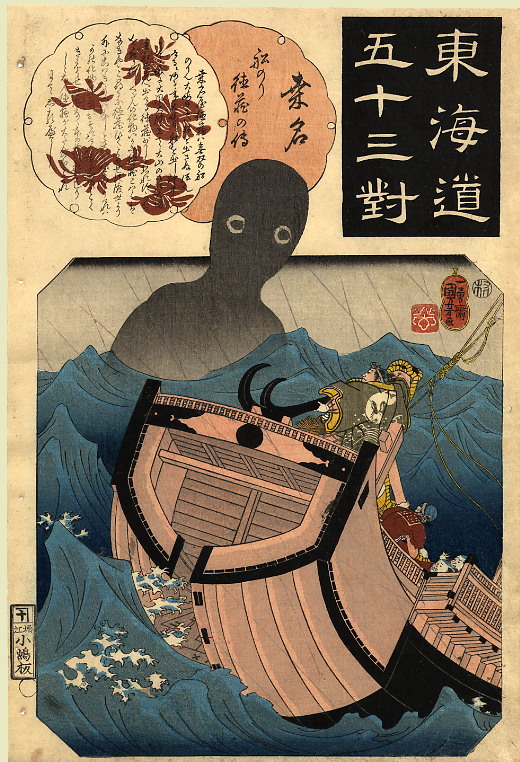
September 26, 2009
Umibōzu
By Brent Swancer
The seas of Japan were once considered a perilous place, inhabited by a rogue’s gallery of roving monsters and vengeful ghosts. Whether it was sea serpents or supernatural entities, Japanese sailors were constantly wary of the dangers the seas could throw at them. Some of the most feared apparitions was known as the Umibōzu, terrifying creatures said to be the spirits of drowned priests.
Umibōzu were massive creatures that struck fear into the hearts of seafarers. These monstrosities were typically described as black or grey in color, with slick, slippery skin and enormous eyes that were sometimes said to glow. The arms of the beasts were variously depicted as small and fin-like, and sometimes described as serpentine, or similar to tentacles. The heads of these creatures were humanoid, with the appearance of a priest’s shaved head, hence their namesake umibōzu; in which umi means “sea” and bōzu the style of shaved head typically found on Japanese priests.
These enormous creatures were said to haunt and terrorize sailors and fishermen, smashing boats or dragging people to their doom. The umibōzu were so feared that many fishermen refused to go out onto the water if one was reported to be in the vicinity, and weapons were typically carried on deck in case one of the monsters was encountered. It was quite typical for boats to make speed towards shore at the first sign of any perceived umibōzu activity, often indicated by huge, black shapes under the water or inexplicable disturbances on the surface.
Japan shares these accounts with similar folklore of mysterious, priest like fish that were said to doom sailors in waters around China. The Chinese version of this beast was known as the sea bōnze (or Buddhist priest), and much like its Japanese counterpart, it was known as a vicious, vengeful entity that attacked seafarers. In China, the sea bōnze was considered so dangerous and so abundant, that it was common practice in some areas for ships to assign a deckhand the task of dancing upon the deck flailing about a red ribbon, which was said to ward the creatures off.
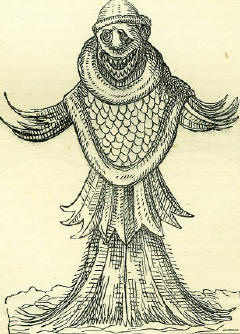
Tales of sea monsters with the appearance of some sort of religious clergy, such as monks, are not solely confined to Asia. Europe also had its stories of similar creatures, with perhaps the most famous being what was known as the “Sea Monk” or “Monk Fish.”
The Sea Monk first came to prominence when a strange sea animal was found off the coast of Denmark in 1546 which looked superficially like a monk. The creature was described as 2.5 meters long, with a human head shaven like that of a monk, and clothes made of scales in the style of a monk’s cloak. The creature had two long fins instead of arms, and its lower torso ended in a broad tail. At the time, it was quite puzzling to those who had found it, and resembled no other sea creatures known to inhabit those waters.

The Swiss naturalist and bibliographer Conrad Gessner also referenced a similar monster found in the Forth of Firth in Scotland, and a sighting off Poland in 1531. Gessner mentioned and pictured the creature in the 4th volume of his 5 volume zoological work Historia Animalum, books that were meant to be an all inclusive zoological inventory and an attempt to describe all known animals. The volumes of this work were also aimed at bridging the ancient world and the modern world. One can find within these pages detailed descriptions and illustrations of all manners of animals, including many that were newly discovered at the time, and even some that are currently unknown to science, such as the Sea Monk. It is unclear how scientifically reliable this work is, as there are many seemingly mythical animals found here, with unicorns given equal treatment alongside rhinoceros.
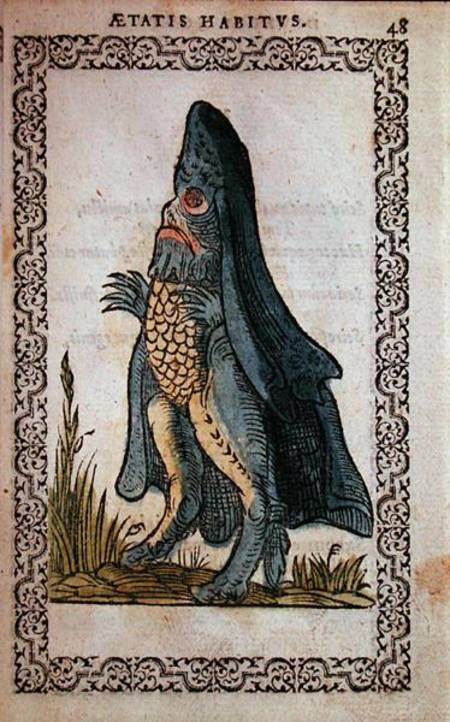
Similar to the Sea Monk was another of these “Sea Clergy” known as the Sea Bishop, also described in Gessner’s Historiae Animalum. In this case, the creature in question resembled a Bishop in appearance, with a humanoid head and a body draped in scales similar to the garb of a bishop and fins for arms. The Sea Bishop is usually depicted as having two legs.

There is a 13th century Polish legend of a captured Sea Bishop that was brought before the King of Poland, upon which it appealed to be set free. When the king finally granted its request, the creature is reported to have made the sign of a cross and disappeared into the depths. Another Sea Bishop was sighted and allegedly even captured in Germany in 1531. Upon its capture, it was said to have eventually died after spending three days in captivity.
One earlier account dating from 1187 AD of a captured Sea Bishop is described in Stow’s Annals, quoted here with the spelling of the time.
“Neere unto Orforde in Suffolke, certain fishers of the sea tooke in their nettes a Fish having the shape of a man in all pointes, which Fish was kept by Barlemew de Glanville, Custos of the castle of Orforde, in the same castle, by the space of six months, and more for a wonder: he spoke not a word. All manner of meates he gladly did eate, but more greedilie raw fishe, after he had crushed out all of the moisture. Oftentimes he was brought to the Church where he showed no tokens of adoration. At length, when he was not well looked to, he stole away to the sea and never after appeared.”
Regardless of the improbability of human-like fish or the accounts of them speaking, appealing to be freed, and making the sign of the cross, it is curious that we have here cases of mysterious creatures from different parts of the world surrounded by the imagery of monks, priests, or bishops. Descriptions of the European Sea Monk and the Chinese Sea Bonze also seem to share similar physical characteristics with the Japanese umibōzu. Is it possible that any of these seemingly folkloric tales are based on a real and possibly even related creature?
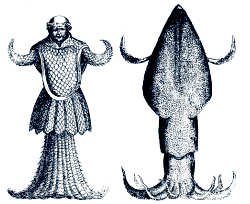
In the early 1850s, Danish zoologist Japetus Steenstrup suggested that the Sea Monk was likely a giant squid, an animal which he himself described and assigned the genus name Architeuthis. By Steenstrup’s rationale, the giant squid’s mantle could be mistaken for the “head” of the creature and its tentacles as its arms and tail. This is perhaps worth looking at as an explanation for the Umibōzu as well for several reasons.
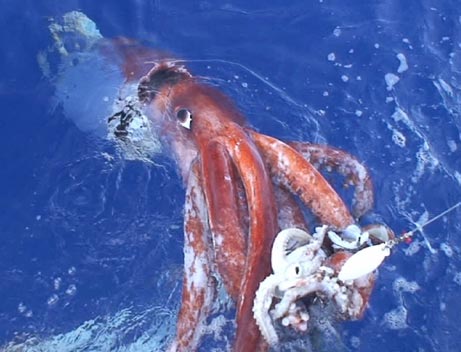
The giant squid is indeed found in Japanese waters, and its appearance in some ways matches descriptions of the umibōzu, such as the serpentine arms and the sheer size of the monster. The rounded mantle may also be seen as somewhat reminiscent of a monk’s head, especially if that was the cultural perception upon seeing the creature. Whether based on reality or tall tales, reports of giant squid attacking boats are also prevalent from many parts of the world, which would be well within the descriptions of the terrifying, ship ravaging behavior present in umibōzu lore. Giant squid are rarely seen near the surface, so this rarity could help to explain the fear they invoked, and perhaps the subsequent addition of folkloric elements.
Many other possible animals have been proposed over the ages for both the European versions and Asian versions of these sea creatures. Some of the animals proposed have included seals, sharks, skates, or rays. The famed Bernard Heuvelmans himself expressed his opinion that the European Sea Monk was based on misidentifications of walruses.


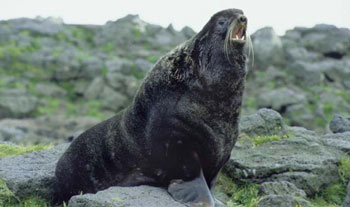
Some of these may have merit as an explanation for the umibōzu, however it is unclear just how likely seasoned fishermen would be to misidentify sea life that they were familiar with. It seems that sharks, rays, pinnipeds, and even giant squid would be known to some extent or other to experienced seafarers. Could fishermen and sailors have for centuries mistaken sharks, rays, and seals as some sort of menacing monster or seafaring ghost? This seems more likely to have occurred with some animal that was far out of its usual range, venturing into waters where it was not typically found.
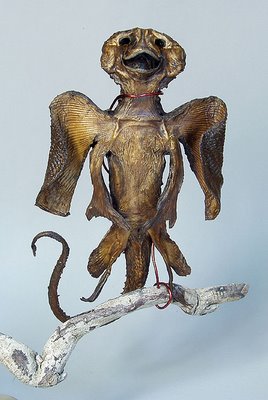
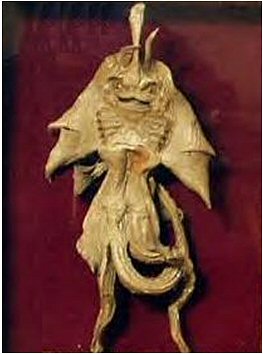

Another possible explanation is that eyewitness sightings were influenced by Jenny Hannivers. A Jenny Hanniver is basically a ray or skate that is dried and preserved, sometimes with a coat of varnish, and arranged or somehow made up to appear to be a mysterious, grotesque monster. These creations have been made and sold by fishermen, sailors, and craftsmen for centuries in both Europe and Japan. Many common folk who saw Jenny Hannivers believed them to be real creatures, and there were rampant misconceptions that these were actual specimens of miniature sea monsters or dragons. Even when the objects were labeled as fake, or when it became widely known that Jenny Hannivers were manmade constructions, the misconception prevailed, most likely because they simply appealed to people’s firm beliefs that such creatures existed. It seems possible that some may have used the existence of Jenny Hannivers to affirm their firm belief in sea monsters and thus might have been inclined to describe a misidentified known animal as such.
Is there a possibility that these accounts represent a complete unknown? There is no doubt that the oceans of the world are home to a great many remaining mysteries. This is a place that we are only beginning to scratch the surface of in terms of exploration, and it is the source of a large number of new species discoveries, with many more to invariably follow. It should come as no surprise at all that an undocumented species could be out there, and may be behind some of these accounts.
Regardless of the exact cause behind these accounts and myths, one thing is clear. The allure of the sea is powerful, and this vast expanse has held a potent fascination for humankind for millennia. Seafarers have long tried to make sense of this place, and the various phenomena tied to it. Perhaps rather than looking for a flesh and blood animal, we should take a moment to consider the perceptions that the mighty oceans can invoke and how they shaped the beliefs of people of all cultures.
Whether the umibōzu is real or not, it remains just one more testament to the powerful effect of nature’s last great frontier on the human psyche. The sea remains, even in modern days, a place where mysteries abound and perhaps will always remain.
To donate to the International Cryptozoology Museum, please, click on the following museum button:
About Loren Coleman
Loren Coleman is one of the world’s leading cryptozoologists, some say “the” leading living cryptozoologist. Certainly, he is acknowledged as the current living American researcher and writer who has most popularized cryptozoology in the late 20th and early 21st centuries.
Starting his fieldwork and investigations in 1960, after traveling and trekking extensively in pursuit of cryptozoological mysteries, Coleman began writing to share his experiences in 1969. An honorary member of Ivan T. Sanderson’s Society for the Investigation of the Unexplained in the 1970s, Coleman has been bestowed with similar honorary memberships of the North Idaho College Cryptozoology Club in 1983, and in subsequent years, that of the British Columbia Scientific Cryptozoology Club, CryptoSafari International, and other international organizations. He was also a Life Member and Benefactor of the International Society of Cryptozoology (now-defunct).
Loren Coleman’s daily blog, as a member of the Cryptomundo Team, served as an ongoing avenue of communication for the ever-growing body of cryptozoo news from 2005 through 2013. He returned as an infrequent contributor beginning Halloween week of 2015.
Coleman is the founder in 2003, and current director of the International Cryptozoology Museum in Portland, Maine.
Filed under Cryptomundo Exclusive, CryptoZoo News, Folklore, Guest Blog